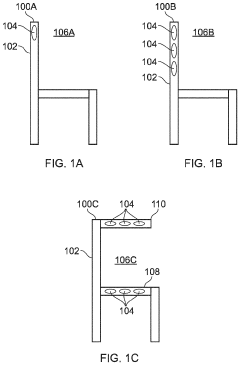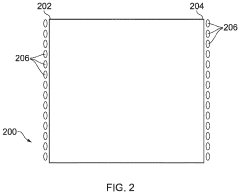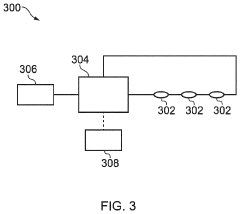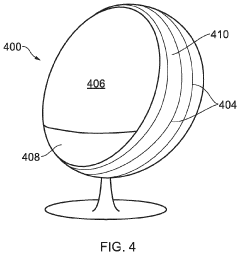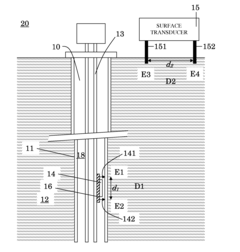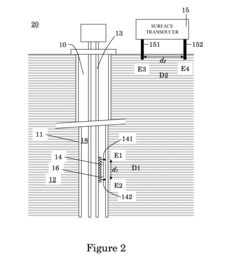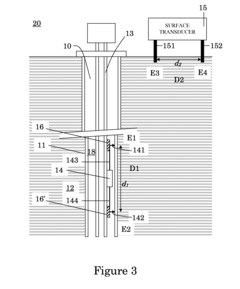How to Conduct Field Studies on Schumann Resonance?
JUN 24, 20259 MIN READ
Generate Your Research Report Instantly with AI Agent
Patsnap Eureka helps you evaluate technical feasibility & market potential.
Schumann Resonance Background and Research Objectives
Schumann resonances, discovered by Winfried Otto Schumann in 1952, are a set of spectrum peaks in the extremely low frequency (ELF) portion of the Earth's electromagnetic field spectrum. These resonances occur between the Earth's surface and the ionosphere, creating a global electromagnetic resonance phenomenon. The fundamental frequency of Schumann resonances is approximately 7.83 Hz, with harmonics at higher frequencies.
The study of Schumann resonances has gained significant attention in recent years due to its potential applications in various fields, including geophysics, atmospheric science, and even human health. Research objectives in this area typically focus on understanding the mechanisms behind these resonances, their variations, and their potential impacts on Earth systems and human well-being.
One primary goal of Schumann resonance research is to develop more accurate models of the Earth-ionosphere cavity and its electromagnetic properties. This involves investigating the factors that influence the resonance frequencies, such as solar activity, geomagnetic storms, and changes in the ionosphere's composition. By improving these models, scientists can better predict and interpret variations in Schumann resonances, which may serve as indicators of global climate change or other large-scale environmental phenomena.
Another important objective is to explore the potential applications of Schumann resonance measurements in various fields. For instance, researchers are investigating the use of Schumann resonances as a tool for monitoring global lightning activity, which could provide valuable insights into the Earth's climate system. Additionally, some studies aim to examine the possible effects of Schumann resonances on biological systems, including human health and cognitive function.
Field studies on Schumann resonances play a crucial role in advancing our understanding of this phenomenon. These studies involve deploying specialized equipment to measure extremely low-frequency electromagnetic fields in various locations around the globe. The objectives of such field studies often include collecting high-quality data on Schumann resonance parameters, such as frequency, amplitude, and phase, under different environmental conditions and geographical locations.
Furthermore, field studies aim to investigate the spatial and temporal variations of Schumann resonances, which can provide insights into global atmospheric dynamics and electromagnetic phenomena. By conducting measurements at multiple sites simultaneously, researchers can study the propagation characteristics of Schumann resonances and their interactions with local and global atmospheric conditions.
In conclusion, the background and research objectives of Schumann resonance studies encompass a wide range of scientific inquiries, from fundamental physics to practical applications in environmental monitoring and human health. As technology advances and our understanding of Earth's electromagnetic environment grows, the field of Schumann resonance research continues to evolve, offering new opportunities for scientific discovery and practical applications.
The study of Schumann resonances has gained significant attention in recent years due to its potential applications in various fields, including geophysics, atmospheric science, and even human health. Research objectives in this area typically focus on understanding the mechanisms behind these resonances, their variations, and their potential impacts on Earth systems and human well-being.
One primary goal of Schumann resonance research is to develop more accurate models of the Earth-ionosphere cavity and its electromagnetic properties. This involves investigating the factors that influence the resonance frequencies, such as solar activity, geomagnetic storms, and changes in the ionosphere's composition. By improving these models, scientists can better predict and interpret variations in Schumann resonances, which may serve as indicators of global climate change or other large-scale environmental phenomena.
Another important objective is to explore the potential applications of Schumann resonance measurements in various fields. For instance, researchers are investigating the use of Schumann resonances as a tool for monitoring global lightning activity, which could provide valuable insights into the Earth's climate system. Additionally, some studies aim to examine the possible effects of Schumann resonances on biological systems, including human health and cognitive function.
Field studies on Schumann resonances play a crucial role in advancing our understanding of this phenomenon. These studies involve deploying specialized equipment to measure extremely low-frequency electromagnetic fields in various locations around the globe. The objectives of such field studies often include collecting high-quality data on Schumann resonance parameters, such as frequency, amplitude, and phase, under different environmental conditions and geographical locations.
Furthermore, field studies aim to investigate the spatial and temporal variations of Schumann resonances, which can provide insights into global atmospheric dynamics and electromagnetic phenomena. By conducting measurements at multiple sites simultaneously, researchers can study the propagation characteristics of Schumann resonances and their interactions with local and global atmospheric conditions.
In conclusion, the background and research objectives of Schumann resonance studies encompass a wide range of scientific inquiries, from fundamental physics to practical applications in environmental monitoring and human health. As technology advances and our understanding of Earth's electromagnetic environment grows, the field of Schumann resonance research continues to evolve, offering new opportunities for scientific discovery and practical applications.
Market Applications of Schumann Resonance Studies
Schumann resonance studies have found diverse market applications across various industries, leveraging the unique properties of these natural electromagnetic frequencies. In the field of environmental monitoring, Schumann resonance measurements are utilized to assess global lightning activity and track climate change impacts. This data is valuable for meteorological agencies, insurance companies, and agricultural businesses in predicting severe weather patterns and managing associated risks.
The healthcare sector has shown increasing interest in Schumann resonance applications. Some medical device manufacturers are developing products that claim to synchronize human biorhythms with the Earth's natural frequencies, purportedly promoting relaxation and overall well-being. While scientific evidence supporting these claims remains limited, there is a growing market for wellness products incorporating Schumann resonance technology.
In the realm of geophysical exploration, Schumann resonance measurements are employed to study the Earth's ionosphere and detect underground structures. Oil and gas companies use this technology to complement traditional prospecting methods, potentially improving the efficiency of resource discovery and extraction processes.
The telecommunications industry has also found applications for Schumann resonance studies. By understanding the behavior of these low-frequency waves, engineers can develop more robust communication systems that are less susceptible to electromagnetic interference. This is particularly relevant for long-range, low-frequency communication systems used in submarine and subterranean environments.
Space weather monitoring represents another significant market application. Schumann resonance observations provide insights into solar activity and its effects on Earth's magnetosphere. This information is crucial for satellite operators, power grid managers, and aviation authorities in mitigating the risks associated with geomagnetic disturbances.
The defense sector has shown interest in Schumann resonance technology for its potential in long-range communication and detection systems. Some military organizations are exploring the use of these natural frequencies for secure, low-bandwidth communications that are difficult to intercept or jam.
As awareness of electromagnetic pollution grows, there is an emerging market for Schumann resonance-based shielding and harmonizing products. These range from personal devices to architectural solutions aimed at creating electromagnetic environments that are perceived as more natural and healthier for human habitation.
While many of these market applications are still in nascent stages, the diverse potential of Schumann resonance studies suggests a growing interdisciplinary field with opportunities for innovation across multiple sectors. As research progresses and technology advances, new applications are likely to emerge, further expanding the market potential of this fascinating natural phenomenon.
The healthcare sector has shown increasing interest in Schumann resonance applications. Some medical device manufacturers are developing products that claim to synchronize human biorhythms with the Earth's natural frequencies, purportedly promoting relaxation and overall well-being. While scientific evidence supporting these claims remains limited, there is a growing market for wellness products incorporating Schumann resonance technology.
In the realm of geophysical exploration, Schumann resonance measurements are employed to study the Earth's ionosphere and detect underground structures. Oil and gas companies use this technology to complement traditional prospecting methods, potentially improving the efficiency of resource discovery and extraction processes.
The telecommunications industry has also found applications for Schumann resonance studies. By understanding the behavior of these low-frequency waves, engineers can develop more robust communication systems that are less susceptible to electromagnetic interference. This is particularly relevant for long-range, low-frequency communication systems used in submarine and subterranean environments.
Space weather monitoring represents another significant market application. Schumann resonance observations provide insights into solar activity and its effects on Earth's magnetosphere. This information is crucial for satellite operators, power grid managers, and aviation authorities in mitigating the risks associated with geomagnetic disturbances.
The defense sector has shown interest in Schumann resonance technology for its potential in long-range communication and detection systems. Some military organizations are exploring the use of these natural frequencies for secure, low-bandwidth communications that are difficult to intercept or jam.
As awareness of electromagnetic pollution grows, there is an emerging market for Schumann resonance-based shielding and harmonizing products. These range from personal devices to architectural solutions aimed at creating electromagnetic environments that are perceived as more natural and healthier for human habitation.
While many of these market applications are still in nascent stages, the diverse potential of Schumann resonance studies suggests a growing interdisciplinary field with opportunities for innovation across multiple sectors. As research progresses and technology advances, new applications are likely to emerge, further expanding the market potential of this fascinating natural phenomenon.
Current Challenges in Field Measurements
Field measurements of Schumann resonances present several significant challenges that researchers must overcome to obtain accurate and reliable data. One of the primary difficulties is the extremely low frequency and amplitude of these signals, typically ranging from 7.83 Hz to about 60 Hz with amplitudes in the picoTesla range. This necessitates highly sensitive equipment capable of detecting such faint electromagnetic oscillations amidst a sea of natural and artificial electromagnetic noise.
Environmental factors pose another substantial challenge. Schumann resonances are global phenomena, but local conditions can significantly impact measurements. Variations in ionospheric conditions, geomagnetic activity, and even local weather patterns can influence the strength and characteristics of the observed resonances. Researchers must carefully account for these variables to ensure the validity of their data.
The presence of man-made electromagnetic interference is an increasingly problematic issue in Schumann resonance field studies. As human technological activity expands, the electromagnetic background noise in many areas has increased dramatically. This interference can mask or distort the subtle Schumann resonance signals, making it crucial to select measurement sites far from urban centers, power lines, and other sources of electromagnetic pollution.
Long-term data collection presents its own set of challenges. Schumann resonances exhibit diurnal and seasonal variations, as well as responses to solar activity cycles. Capturing these long-term patterns requires continuous monitoring over extended periods, often years. This demands robust, low-maintenance equipment capable of operating reliably in potentially harsh field conditions for prolonged durations.
Data processing and analysis also present significant hurdles. The raw signals collected in field measurements contain a complex mixture of Schumann resonances, local noise, and other natural electromagnetic phenomena. Sophisticated signal processing techniques are required to isolate the Schumann resonance components and extract meaningful information. This often involves advanced spectral analysis methods and careful filtering to separate the desired signals from background noise.
Calibration and standardization of measurement equipment across different research sites is another critical challenge. To compare data from various locations and studies effectively, there must be a consistent approach to equipment setup, data collection protocols, and analysis methods. However, achieving this standardization is complicated by the diverse range of environments in which measurements are conducted and the variety of equipment used by different research teams.
Finally, the interpretation of Schumann resonance data in the context of global phenomena adds another layer of complexity. Researchers must correlate their localized measurements with global patterns and events, requiring a comprehensive understanding of the Earth-ionosphere system and its interactions with solar and cosmic influences. This interdisciplinary nature of Schumann resonance research demands collaboration across various fields, including atmospheric science, geophysics, and space weather studies.
Environmental factors pose another substantial challenge. Schumann resonances are global phenomena, but local conditions can significantly impact measurements. Variations in ionospheric conditions, geomagnetic activity, and even local weather patterns can influence the strength and characteristics of the observed resonances. Researchers must carefully account for these variables to ensure the validity of their data.
The presence of man-made electromagnetic interference is an increasingly problematic issue in Schumann resonance field studies. As human technological activity expands, the electromagnetic background noise in many areas has increased dramatically. This interference can mask or distort the subtle Schumann resonance signals, making it crucial to select measurement sites far from urban centers, power lines, and other sources of electromagnetic pollution.
Long-term data collection presents its own set of challenges. Schumann resonances exhibit diurnal and seasonal variations, as well as responses to solar activity cycles. Capturing these long-term patterns requires continuous monitoring over extended periods, often years. This demands robust, low-maintenance equipment capable of operating reliably in potentially harsh field conditions for prolonged durations.
Data processing and analysis also present significant hurdles. The raw signals collected in field measurements contain a complex mixture of Schumann resonances, local noise, and other natural electromagnetic phenomena. Sophisticated signal processing techniques are required to isolate the Schumann resonance components and extract meaningful information. This often involves advanced spectral analysis methods and careful filtering to separate the desired signals from background noise.
Calibration and standardization of measurement equipment across different research sites is another critical challenge. To compare data from various locations and studies effectively, there must be a consistent approach to equipment setup, data collection protocols, and analysis methods. However, achieving this standardization is complicated by the diverse range of environments in which measurements are conducted and the variety of equipment used by different research teams.
Finally, the interpretation of Schumann resonance data in the context of global phenomena adds another layer of complexity. Researchers must correlate their localized measurements with global patterns and events, requiring a comprehensive understanding of the Earth-ionosphere system and its interactions with solar and cosmic influences. This interdisciplinary nature of Schumann resonance research demands collaboration across various fields, including atmospheric science, geophysics, and space weather studies.
Existing Field Study Methodologies
01 Schumann Resonance-based therapeutic devices
Various therapeutic devices have been developed that utilize Schumann Resonance frequencies for health and wellness purposes. These devices aim to simulate the natural electromagnetic frequencies of the Earth to promote relaxation, improve sleep quality, and enhance overall well-being. Some devices incorporate Schumann Resonance generators or emitters into wearable items or household appliances.- Schumann resonance devices for health and wellness: Various devices have been developed to generate or simulate Schumann resonances for potential health benefits. These devices aim to create electromagnetic fields that mimic the natural frequencies of the Earth, which some believe can improve well-being, reduce stress, and enhance relaxation.
- Schumann resonance in environmental monitoring: Schumann resonance measurements are used in environmental monitoring systems. These systems can detect changes in the Earth's electromagnetic field, potentially providing insights into atmospheric conditions, climate change, and natural phenomena such as earthquakes or solar activity.
- Integration of Schumann resonance in electronic devices: Electronic devices, including smartphones, wearables, and home appliances, are being designed to incorporate Schumann resonance technology. These devices aim to counteract the potential negative effects of artificial electromagnetic fields and provide users with a more natural electromagnetic environment.
- Schumann resonance in meditation and relaxation tools: Specialized tools and equipment for meditation and relaxation have been developed that utilize Schumann resonance frequencies. These tools aim to create an optimal environment for mindfulness practices, potentially enhancing the effectiveness of meditation sessions and promoting overall well-being.
- Schumann resonance in agricultural applications: Research and development efforts are exploring the potential benefits of Schumann resonance in agriculture. This includes the use of Schumann resonance-based technologies to improve plant growth, increase crop yields, and enhance overall agricultural productivity by simulating natural electromagnetic conditions.
02 Schumann Resonance in environmental monitoring
Schumann Resonance measurements are used in environmental monitoring systems to detect and analyze changes in the Earth's electromagnetic field. These systems can provide valuable data for studying atmospheric phenomena, climate change, and potential natural disasters. Some applications include early warning systems for earthquakes or severe weather events.Expand Specific Solutions03 Schumann Resonance in meditation and mindfulness practices
Schumann Resonance frequencies are incorporated into meditation and mindfulness tools to enhance the practice experience. These tools may include audio recordings, mobile applications, or specialized meditation devices that generate or simulate Schumann Resonance frequencies. The aim is to create a more immersive and effective meditation environment by aligning the practitioner with Earth's natural frequencies.Expand Specific Solutions04 Schumann Resonance in agriculture and plant growth
Research has explored the potential benefits of Schumann Resonance frequencies on plant growth and agricultural practices. Some inventions propose using Schumann Resonance generators or simulators in greenhouses or farming environments to enhance crop yields, improve plant health, and increase resistance to pests or diseases. These applications aim to create a more natural electromagnetic environment for plants.Expand Specific Solutions05 Schumann Resonance in electromagnetic shielding
Inventions have been developed to incorporate Schumann Resonance frequencies into electromagnetic shielding solutions. These technologies aim to protect against harmful electromagnetic radiation while maintaining exposure to beneficial Earth frequencies. Applications include protective clothing, building materials, and electronic device cases that block artificial EMF while allowing Schumann Resonance frequencies to pass through.Expand Specific Solutions
Key Research Institutions and Scientists
The field of Schumann Resonance research is in a mature stage, with established methodologies for conducting field studies. The global market for related equipment and research is relatively small but growing, driven by increasing interest in Earth-ionosphere cavity resonances and their potential applications. Technologically, the field is moderately advanced, with companies like Siemens Healthineers AG, Koninklijke Philips NV, and GE Precision Healthcare LLC contributing to the development of sensitive magnetometers and data analysis tools. Universities such as the University of Zurich and Vanderbilt University are at the forefront of academic research, pushing the boundaries of our understanding of these low-frequency electromagnetic phenomena.
The Regents of the University of California
Technical Solution: The University of California has developed a comprehensive approach to conducting field studies on Schumann Resonance. Their method involves deploying a network of highly sensitive magnetometers across various locations to capture the global electromagnetic resonances. They utilize advanced signal processing techniques to filter out local noise and isolate the Schumann Resonance signals. The university has also developed custom software for real-time data analysis and visualization, allowing researchers to observe variations in the resonance patterns correlated with solar activity, ionospheric conditions, and global lightning activity.
Strengths: Extensive network of sensors providing global coverage; Advanced signal processing capabilities; Real-time data analysis. Weaknesses: High cost of maintaining a large sensor network; Potential for interference from human-made electromagnetic sources.
Cornell University
Technical Solution: Cornell University has pioneered a novel approach to Schumann Resonance field studies using a combination of ground-based and satellite-based measurements. Their method integrates data from custom-built extremely low frequency (ELF) receivers on the ground with measurements from satellites equipped with electric field instruments. This dual approach allows for a more comprehensive understanding of the global electromagnetic environment. Cornell researchers have also developed sophisticated algorithms to separate Schumann Resonance signals from other natural and artificial ELF emissions, enhancing the accuracy of their observations.
Strengths: Comprehensive approach combining ground and space-based measurements; Advanced signal separation techniques. Weaknesses: Reliance on satellite data may introduce additional complexities and potential data gaps.
Innovative Sensor Technologies
A magnetic field exposure system and uses thereof
PatentPendingUS20230372726A1
Innovation
- A magnetic field exposure system generating an amplitude-modulated low frequency magnetic field with a carrier frequency of 360 to 450 Hz and a modulation frequency of 0.5 to 100 Hz, providing a field strength of 0.5 to 250 μT, specifically designed to enhance cell survival, proliferation, reduce stress, and promote tissue regeneration.
Method and Apparatus for Transmitting or Receiving Information Between A Downhole Equipment and Surface
PatentActiveUS20140318767A1
Innovation
- A method and apparatus using transducers with electrodes in electrical contact with the casing to transmit and receive electric signals, with low electrical resistance to ensure effective communication, and optionally employing relay transducers to increase range and network communication capabilities, while insulation and shielding enhance signal quality and protect against interference.
Environmental Factors Affecting Measurements
Environmental factors play a crucial role in conducting accurate field studies on Schumann resonance. These factors can significantly influence the quality and reliability of measurements, necessitating careful consideration and mitigation strategies. One of the primary environmental factors affecting Schumann resonance measurements is electromagnetic interference (EMI) from both natural and artificial sources. Natural sources of EMI include lightning strikes, solar activity, and geomagnetic disturbances, which can introduce noise and distortions into the recorded signals. Artificial sources, such as power lines, radio transmitters, and electronic devices, can also contribute to background noise and potentially mask the subtle Schumann resonance signals.
Atmospheric conditions, including temperature, humidity, and pressure, can impact the propagation of electromagnetic waves in the Earth-ionosphere cavity. Variations in these parameters can lead to changes in the resonance frequencies and amplitudes, requiring researchers to account for these fluctuations in their data analysis. Seasonal and diurnal variations in the ionosphere's properties further complicate the measurement process, as they can alter the characteristics of the Schumann resonance signals.
Geographical location is another critical factor affecting field studies. The proximity to the equator, where lightning activity is most intense, can influence the strength and clarity of the recorded signals. Additionally, local geological features, such as mineral deposits or underground water sources, may affect the electromagnetic properties of the surrounding area, potentially impacting the measurements.
Weather conditions, particularly thunderstorms and precipitation, can introduce significant noise and interference into the recordings. Researchers must carefully select measurement sites and timing to minimize the impact of adverse weather on their data collection efforts. Furthermore, the presence of nearby bodies of water, such as oceans or large lakes, can influence the propagation of electromagnetic waves and potentially affect the observed Schumann resonance characteristics.
Human activity in the vicinity of the measurement site can also introduce unwanted interference. Industrial operations, transportation systems, and even the movement of people and vehicles can generate electromagnetic noise that may contaminate the recorded signals. Researchers must carefully select remote locations or implement appropriate shielding techniques to mitigate these anthropogenic influences.
To address these environmental challenges, field studies on Schumann resonance often employ various strategies. These may include the use of multiple measurement sites to cross-validate results, long-term data collection to account for temporal variations, and advanced signal processing techniques to filter out unwanted noise and interference. Additionally, researchers may utilize specialized equipment, such as magnetically shielded enclosures or highly sensitive magnetometers, to improve the signal-to-noise ratio and enhance the accuracy of their measurements.
Atmospheric conditions, including temperature, humidity, and pressure, can impact the propagation of electromagnetic waves in the Earth-ionosphere cavity. Variations in these parameters can lead to changes in the resonance frequencies and amplitudes, requiring researchers to account for these fluctuations in their data analysis. Seasonal and diurnal variations in the ionosphere's properties further complicate the measurement process, as they can alter the characteristics of the Schumann resonance signals.
Geographical location is another critical factor affecting field studies. The proximity to the equator, where lightning activity is most intense, can influence the strength and clarity of the recorded signals. Additionally, local geological features, such as mineral deposits or underground water sources, may affect the electromagnetic properties of the surrounding area, potentially impacting the measurements.
Weather conditions, particularly thunderstorms and precipitation, can introduce significant noise and interference into the recordings. Researchers must carefully select measurement sites and timing to minimize the impact of adverse weather on their data collection efforts. Furthermore, the presence of nearby bodies of water, such as oceans or large lakes, can influence the propagation of electromagnetic waves and potentially affect the observed Schumann resonance characteristics.
Human activity in the vicinity of the measurement site can also introduce unwanted interference. Industrial operations, transportation systems, and even the movement of people and vehicles can generate electromagnetic noise that may contaminate the recorded signals. Researchers must carefully select remote locations or implement appropriate shielding techniques to mitigate these anthropogenic influences.
To address these environmental challenges, field studies on Schumann resonance often employ various strategies. These may include the use of multiple measurement sites to cross-validate results, long-term data collection to account for temporal variations, and advanced signal processing techniques to filter out unwanted noise and interference. Additionally, researchers may utilize specialized equipment, such as magnetically shielded enclosures or highly sensitive magnetometers, to improve the signal-to-noise ratio and enhance the accuracy of their measurements.
Data Analysis and Interpretation Techniques
Data analysis and interpretation techniques are crucial components in conducting field studies on Schumann Resonance. The process begins with the collection of raw data from various sensors and equipment deployed in the field. This data typically includes electromagnetic field measurements, frequency spectra, and temporal variations of the resonance.
One of the primary techniques used in analyzing Schumann Resonance data is spectral analysis. Fast Fourier Transform (FFT) algorithms are commonly employed to convert time-domain signals into frequency-domain representations. This allows researchers to identify the characteristic peaks associated with Schumann Resonance, typically occurring at frequencies of 7.83 Hz, 14.3 Hz, 20.8 Hz, and so on.
Time-frequency analysis techniques, such as wavelet transforms or short-time Fourier transforms, are often utilized to examine the temporal evolution of Schumann Resonance signals. These methods provide insights into how the resonance characteristics change over time, which can be correlated with various geophysical and atmospheric phenomena.
Statistical methods play a significant role in interpreting Schumann Resonance data. Correlation analyses are used to investigate relationships between Schumann Resonance parameters and other environmental factors, such as solar activity, geomagnetic disturbances, or meteorological conditions. Time series analysis techniques, including autoregressive models and trend analysis, help in identifying long-term patterns and cyclical variations in the resonance.
Signal processing techniques are essential for enhancing the quality of Schumann Resonance data. Noise reduction algorithms, such as adaptive filtering or principal component analysis, are applied to separate the resonance signals from background noise and interference. These methods improve the signal-to-noise ratio and enable the detection of subtle variations in the resonance characteristics.
Machine learning and artificial intelligence techniques are increasingly being applied to Schumann Resonance data analysis. Clustering algorithms can identify distinct patterns or modes in the resonance behavior, while neural networks can be trained to predict resonance characteristics based on various input parameters. These advanced techniques offer new possibilities for extracting meaningful information from complex datasets.
Visualization tools play a crucial role in interpreting Schumann Resonance data. Spectrograms, which display frequency content over time, are commonly used to represent the resonance patterns visually. Three-dimensional plots and heat maps are employed to illustrate spatial variations in resonance characteristics across different measurement locations.
One of the primary techniques used in analyzing Schumann Resonance data is spectral analysis. Fast Fourier Transform (FFT) algorithms are commonly employed to convert time-domain signals into frequency-domain representations. This allows researchers to identify the characteristic peaks associated with Schumann Resonance, typically occurring at frequencies of 7.83 Hz, 14.3 Hz, 20.8 Hz, and so on.
Time-frequency analysis techniques, such as wavelet transforms or short-time Fourier transforms, are often utilized to examine the temporal evolution of Schumann Resonance signals. These methods provide insights into how the resonance characteristics change over time, which can be correlated with various geophysical and atmospheric phenomena.
Statistical methods play a significant role in interpreting Schumann Resonance data. Correlation analyses are used to investigate relationships between Schumann Resonance parameters and other environmental factors, such as solar activity, geomagnetic disturbances, or meteorological conditions. Time series analysis techniques, including autoregressive models and trend analysis, help in identifying long-term patterns and cyclical variations in the resonance.
Signal processing techniques are essential for enhancing the quality of Schumann Resonance data. Noise reduction algorithms, such as adaptive filtering or principal component analysis, are applied to separate the resonance signals from background noise and interference. These methods improve the signal-to-noise ratio and enable the detection of subtle variations in the resonance characteristics.
Machine learning and artificial intelligence techniques are increasingly being applied to Schumann Resonance data analysis. Clustering algorithms can identify distinct patterns or modes in the resonance behavior, while neural networks can be trained to predict resonance characteristics based on various input parameters. These advanced techniques offer new possibilities for extracting meaningful information from complex datasets.
Visualization tools play a crucial role in interpreting Schumann Resonance data. Spectrograms, which display frequency content over time, are commonly used to represent the resonance patterns visually. Three-dimensional plots and heat maps are employed to illustrate spatial variations in resonance characteristics across different measurement locations.
Unlock deeper insights with Patsnap Eureka Quick Research — get a full tech report to explore trends and direct your research. Try now!
Generate Your Research Report Instantly with AI Agent
Supercharge your innovation with Patsnap Eureka AI Agent Platform!
